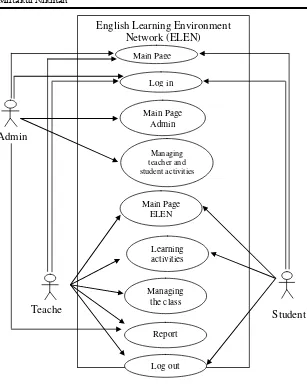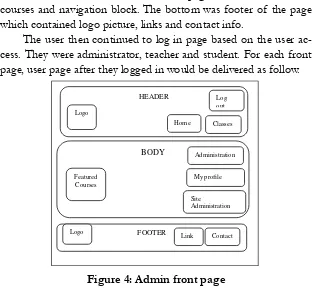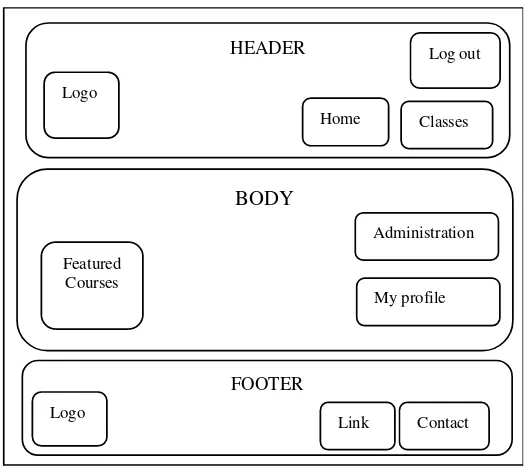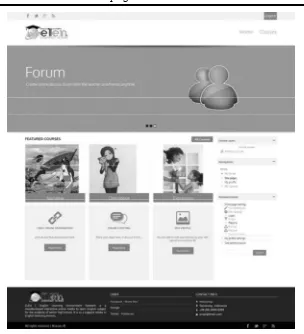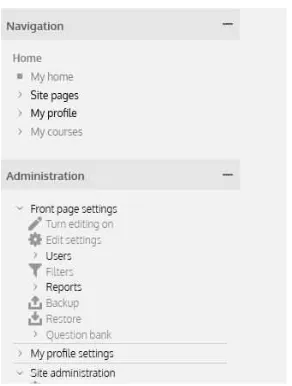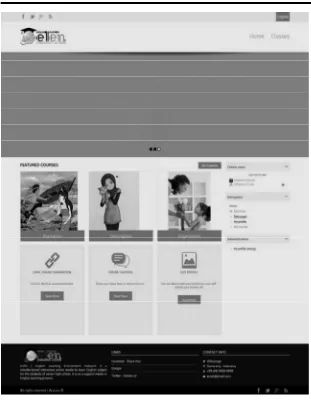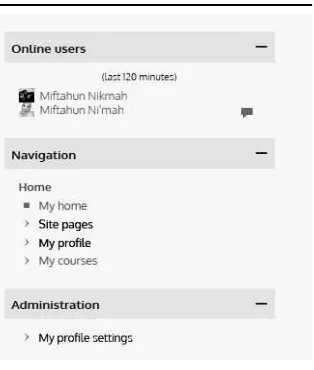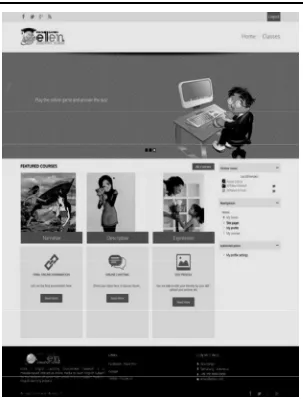DEVELOPING MOODLE BASED
INTERACTIVE ONLINE MEDIA TO
TEACH NARRATIVE READING IN SMA N
13 SEMARANG
Miftakul Nikmah
Undergraduate Program of UIN Walisongo
Abstract
This research employs research and development model. The conducted development was the interactive online media based e-learning of English subject with the Moodle application in SMA N 13 Semarang. Moodle (Modular Object-Oriented Dy-namic Learning Environment) is a course management system for online learning using PHP and MySQL. The learning instrument development design was carried out using the six steps of Borg and Gall model. They were need analysis, planning, developing preliminary Moodle-based interactive online media, preliminary fi eld testing, Moodle-based interactive online media revision, and main fi eld testing. The data collecting techniques used in this re-search were interview, questionnaire and documentation. The de-veloping result of interactive online media Moodle-based to teach narrative reading could be accessed at http://www.elen.airybelle. com.
Introduction
E-learning involves all forms of ICT, across all dimensions of the learning processes. E-learning can be both a distinct area of study and part of the wider mosaic of learning, knowledge manage-ment and information exchange within electronic environmanage-ment (Al-lan, 2003). Today e-learning refers to a mixture of technologies that are often encapsulated within an environment or management sys-tem. Early online or virtual learning environments allowed students to interact with content, fellow students, and faculty within the one web site. In addition, students can create content within the virtual environment. These are now referred to as Learning Management Systems (LMS), virtual learning environments, or course manage-ment systems (Richard, 2008).
English is one of the international languages used in country throughout the world, including Indonesia. As the rst language, English is taught as a compulsory subject from junior high school up to senior high school in today s Indonesian educational system. But in fact, English as a foreign language is considered as one of the most dif cult lessons. In our country, students are usually afraid of joining foreign language classes (Siti, 2008). In applied language over the last decades, it has been common to divide language into the four skills and then to add grammar, vocabulary and pho-nology to them (Cameron, ). It is applied in teaching language at senior high school includes four language skills; listening, speaking, reading, and writing. Those four skills are taught in an integrated manner.
internet had many bene ts such applications as e-mail, instant mes-saging, audio and video streaming, Web browsing, and e-commerce and others (Apostolis, 2004). But, the teachers only asked students to search the tasks from the internet and then sending it by email. The English teachers used explaining method, repeating words or sentences and answering questions. It caused not all students did not enjoy the teaching and learning process. So, they did not under-stand the material and did not achieve the minimum score (75).
Based on the theory of the importance of e-learning, the inter-net advantages and the problem of teaching reading, the researcher would conduct a research on applying e-learning by using Learning Management System to solve those problems. She chose to apply e-learning Moodle-based to teach narrative reading in SMA Negeri 13 Semarang for tenth grade.
Research Method
Design
Figure 1: Borg and Gall model steps scheme
development. ISO/IEC 12207 is an international standard for soft-ware life-cycle processes. It aims to be the standard that de nes all the tasks required for developing and maintaining software. In software development, there is a standard process called SDLC. The most popular one is Waterfall Model.
Need Analysis
Design
Implementation
Testing
Operation & Maintenance
Figure 2.1 Waterfall software model
software solution after delivery and deployment to re ne output, correct errors, and improving performance and quality. (Bassil, 2012)
The next step was that the researcher designed the system planning of the interactive online media. It was implemented by using use case system diagram. In the use case system diagram, there are three actors related to this online media system. They are student, teacher and admin. Next, the researcher conducted the developing product. It was the product design that would be applied in fi eld testing. The next step, the validation was done by online media expert of UIN Walisongo Semarang and the online media expert of SMAN 13 Semarang. Based on the inputs and evaluation experts, then the online media Moodle-based was re-vised to further improve quality and get a decent product to be applied
Preliminary fi eld testing and main fi eld testing were done in the different
class. The purpose of the preliminary fi eld test is to obtain an initial qualitative
evaluation of the new educational product (Borg & Gall, 1984). All phases of the R & D cycle involve product evaluation. It is important to establish
fi eld sites similar to those in which the product will be used when it is fully
developed. Thepurpose of the main fi eld test in R & D cycle is to determine whether the product under development meets its per-formance objectives. Generally an experimental design is used to answer this question(Borg & Gall, 1984).
The data collecting techniques in this research are interviewing, questionnaire, and documentation. The researcher will explain the three of them as follows.
The fi rst technique was interviewing. Interviewing is as a foundation of knowledge upon which to develop a given educa-tional product.
of the product prototype. Besides, it can help researcher know the weaknesses of the product. The questionnaire was given to the expert reviewer consisting of instructional design expert and teacher. They assess the prototype and give suggestion to revise the prototype. The test was undertaken from the questionnaire validation of the test expert. After the test was valid based on the questionnaire validation, the test would be given to the subjects.
The third technique was documentation. It is used to look for the data concerning matters or the variables that take the form of the note, transcript, book, newspaper, magazine, inscription, notes of a meeting, agenda, etc. The researcher used the docu-ments related to the object of research such as students’ name list and lesson plan.
Before the researcher used the instruments to collect data, the instruments were consulted to the instructor who guided her in conducting the research so that the content validity of the in-strument can be achieved.
Result and Discussion
The result of Moodle-based interactive online media prototype was based on Borg and Gall model and it was matched with water-fall software model.
The need analysis was done to search information on how im-portant was Moodle-based interactive online media would be de-veloped. It consisted of review the literature. From the data of the interview, the researcher got a conclusion that English teachers did not employ yet in using internet effectively, whereas there was a training of e-learning process for the teachers in the school.
Student
Figure 2: Use case diagram
(can populate a course with activities and provide learner feedback - e.g. grades, assignment comments etc.), Teacher without Editing Permissions (can provide learner feedback only - e.g. grades, assign-ment comassign-ments etc). Administrator (can do anything and go any-where within Moodle) (Bryan, 2005).
The planning concerned with the determining of users access eld in this online media. There are three main users; administrator, teacher and students. Administrator could access main page admin and manage teacher and students activity after logged in. Teacher could access main page ELEN, learning activities, manage class and report after logged in. And student could access main page ELEN and learning activities.
The researcher also determined Bitnami local host for of ine installation and purchased hosting and domain website. To access Moodle-based interactive online media by internet, it was needed a domain and web hosting to put the program les in web server. The speci cation of domain and web hosting Moodle-based interactive online media are as follows.
Table 1:Speci cation of domain and web hosting
Main domain airybelle.com
Subdomain elen.airybelle.com
Disk Space 500 MB
Monthly Bandwidth Transfer 1.21 GB / 19.53 GB
Apache version 2.2.27
PHP version 5.4.34
MySQL version 5.5.40-MariaDB
Operating system Linux
Interface design of each user access eld is as follows.
The page was divided into three sections. The top was header of the page. It consisted of logo picture, and button of log in, home and classes. The center was main course page, divided into featured courses and navigation block. The bottom was footer of the page which contained logo picture, links and contact info.
The user then continued to log in page based on the user ac-cess. They were administrator, teacher and student. For each front page, user page after they logged in would be delivered as follow.
HEADER
The page was divided into three sections. The top was header of the page. It consisted of logo picture, and button of log out, home and classes. The center was body page, divided into featured courses and administration block, my pro le and site administration setting. The bottom was footer of the page which contains logo picture, links and contact information.
The next user was teacher. He had same page access with the administrator. But there was not site administration setting.
HEADER
Figure 5: Teacher front page
The page was divided into three sections. The top was header of the page. It consisted of logo picture, and button of log out, home and classes. The center was body page, divided into featured courses, administration block and my pro le setting. The bottom was footer of the page which contained logo picture, links and con-tact information.
HEADER
BODY
FOOTER
Logo
Home
Featured Courses
Classes Log out
Logo
Link Contact My profile Administration
Figure 6: Student front page
The page was divided into three sections. The top was header of the page. It consisted of logo picture, and button of log out, home and classes. The center was body page, divided into featured courses and administration, my pro le setting. The bottom was footer of the page which contains logo picture, links and contact information.
Figure 7: Admin front page.
Figure 8: Admin s Blocks
Figure 9: Teacher front page
Figure 10: Teacher s Blocks
Figure 11: Student s front page
The header and footer of student front page were same
content with administrator and teacher front pages. It consisted of
logo, button of log out, home and classes. The main page divided
into featured courses, navigation and administration block and
Figure 12: Student’s Blocks
In the administration block, student could edit pro le and check the grade.
After the Moodle based interactive online media was created in complete design; the next step was testing or expert validations. The material experts in this research were Agus Prayoga, an English lecturer of UIN Walisongo Semarang, and Nasri Sunarsih, an Eng-lish teacher of SMAN 13 Semarang. The online media experts are Maya Rini Handayani, Communication lecturer of UIN Walisongo Semarang, and Muhammad Tafrikhan, an Information Technology and Communication teacher of SMAN 13 Semarang. The average of the material validation result was 87. 5 %. It was valid criterion and could be used with little revision.
The students activities in the preliminary eld testing are as follow. They logged into http://elen.airybelle.com. They used the username and passwords given by the teacher. Then, they edited their pro les. In the narrative course page, they discussed the topic, learned the material, played the crossword game and did the nal examination. The average of the result of nal examination was 80 and the average of crossword game was 73.50. All the students expressed their opinions on discussion forum.
No Component Revision
1 Less image in front page Adding three images on the front page
2 Too small font type words
in material page Be larger small font type
3 It was limited time to do the quizzes
Managing time based on the quiz needed and the lesson time of English subject Table 4.5 Revision based on the student s suggestions
Main eld testing was conducted in the different class from the preliminary eld testing. In this eld testing, they did not edit their pro les in the same time because of limited time. Username and password have been prepared by the teacher for them. So, they just logged in using the appropriate username and password given. They discussed with friends, played the quizzes and did the nal examination.
The average of student s questionnaire result was 78.0 % (very good qualifying). So, the Moodle-based interactive online media was valid or suitable for them. The supporting data was taken from their scores. After main eld testing was conducted, the students get signi cant improvement in their score. So the score can be described as follow. In the rst quiz, the average score was 89.40. Whereas, in the nal examination, the average score was 79.60. The average of all courses was 84.50.
Conclusion
REFERENCES
Bassil, Youssef. 2014. A Simulation Model for the Waterfall Soft-ware Development Life Cycle. International Journal of En-gineering & Technology (iJET ). ISSN: 2049-3444,( Vol. 2, No. 5, 2012) available at http://iet-journals.org/archive/2012/ may_vol_2_no_5/255895133318216.pdf at November, 19th.
Caladine, Richard. 2008.Enhancing E- Learning with Media Rich Content and Interactions.New York: Information Science publishing.
Cameron, Lynne. Teaching Language to Young Learners. Cambridge: Cambridge.
Cooch, Mary. 2009. Moodle 1.9 for Teaching 7-14 Year Olds Beginner s Guide, Birmingham, UK: Packt Publishing Ltd.
Gall, M, D., & Borg, W. R. 1983. Educational Research; An Introduc-tion. Fourth Edition. USA: Pearson Education.
Henderson, Allan J. 2003.E-Learning Question and Answer Book. New York: Amacom.
Herrity, Mike. 2014. The Personal learning Environment Moving Platform Beyond the VLE and Share Point Learning Plat-form. Available at http://mike herrity s blog.com at November, 18th.
Salkintzis, Apostolis K, Ed. 2004.Mobile Internet Enabling Technologies and Services. Washington: Crc Press.
Tarwiyah, Siti. 2008. Modul Game and Songs, Practical Ideas to Teach Language. Semarang: Unpublished.

